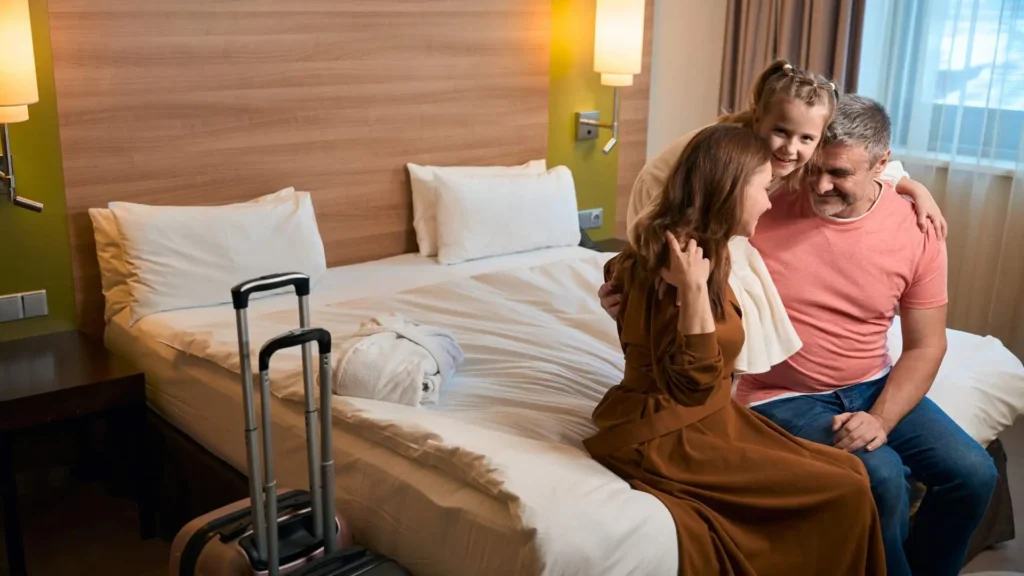Table of Contents
Packing may not be the most glamorous part of travel, but it often decides whether your trip feels smooth or stressful. For budget travelers, luggage choices carry more weight than they might think — quite literally. Checked bags don’t just add bulk, they add fees that can make a “cheap” flight suddenly expensive. In some cases, the baggage fee costs more than the ticket itself.
That’s why more travelers are adopting a carry-on only system. It’s not just about fitting everything into a small bag; it’s about rethinking how you travel. A streamlined approach cuts costs, reduces headaches, and gives you the flexibility to move freely across airports, buses, trains, and budget airlines.
In this blog, we’ll break down how to embrace the carry-on only system for budget travel. From choosing the right bag and clothing strategies to packing hacks and common mistakes to avoid, you’ll get a complete guide to traveling light without sacrificing essentials. We’ll also show how Beem’s Budget Planner can help you quantify the savings and stick to your financial goals while on the road.
Why Go Carry-On Only?
Saving Money on Flights
The most obvious advantage of carry-on travel is avoiding checked baggage fees. Many budget airlines use luggage as a profit center, charging anywhere from $30 to $60 per bag, per leg. If you have multiple flights, those fees add up quickly. On a round-trip with connections, you might spend $100–$200 just to bring a suitcase.
By committing to a carry-on only system, you eliminate that cost entirely. That money can be redirected toward experiences, meals, or even extending your trip. For long-term travelers or frequent flyers, the savings compound dramatically over time.
It also protects you from surprise charges. Some airlines enforce stricter policies at the gate, where overstuffed or oversized bags can incur last-minute fees. With a properly sized carry-on, you sidestep these unwelcome expenses.
Reducing Stress and Time
Beyond the money, carry-on only saves you time. Checked luggage means arriving earlier at the airport to drop it off and waiting at baggage claim after every flight. Those minutes add up — especially on multi-leg trips.
Traveling with just a carry-on allows you to breeze through airports. You walk past the check-in lines, skip baggage claim entirely, and move straight to your next destination. If you’ve ever landed late at night and waited 45 minutes for your bag, you’ll appreciate this advantage.
It also reduces risk. Lost or delayed luggage is a common travel nightmare, but with carry-on only, your bag stays with you. Peace of mind is hard to put a price on, but it makes every trip less stressful.
Flexibility During Travel
Budget travelers often move between different forms of transport: budget airlines, buses, trains, or rideshares. Lugging a heavy suitcase makes every transfer harder. Carry-on only makes you nimble enough to adapt to spontaneous changes.
Want to hop on a last-minute bus? Easier with one bag. Need to walk a mile from the station to your guesthouse? A carry-on makes it manageable. Even in crowded public transit, a compact bag fits better than a bulky suitcase.
Flexibility isn’t just practical — it opens doors. You’ll be more willing to take detours, explore new places, or change plans if your luggage doesn’t weigh you down.
Building the Carry-On Only System
Choosing the Right Bag
The foundation of the carry-on system is, of course, the bag itself. The two main options are backpacks and rolling suitcases. Backpacks give more mobility, especially for cobblestoned streets or crowded areas. Rolling suitcases, meanwhile, are easier on your back and often more organized.
Airline size limits usually fall around 22 x 14 x 9 inches (56 x 36 x 23 cm). Always check restrictions for your airline — budget carriers can be stricter than full-service ones. Choosing a bag that fits under all major limits ensures consistency across trips.
Features to look for include durable zippers, multiple compartments, padded straps (for backpacks), and expandability. Investing in a good-quality carry-on pays off quickly by avoiding replacements and keeping your belongings safe.
Clothing Strategy
The biggest challenge of carry-on packing is clothing. The trick is building a versatile wardrobe based on layering and mix-and-match pieces. Neutral colors like black, navy, and gray work well across outfits, while layering lets you adapt to different climates.
The general rule is to pack for one week, regardless of trip length. That means 5–7 days’ worth of clothing and planning to do laundry on the road. This reduces bulk and makes packing manageable.
Shoes are often the space hog. Limit yourself to two pairs: one for walking and one versatile pair for evenings or specific activities. Wearing your bulkiest pair on travel days saves room in your bag.
Packing Tools and Accessories
Packing cubes are game-changers for organization. They compress clothes and separate categories like shirts, pants, or underwear. Compression bags go a step further, shrinking items like jackets.
For toiletries, carry-on restrictions mean liquids must be under 100 ml and fit in a quart-sized bag. Switching to solid toiletries like shampoo bars or soap bars helps you pack lighter while staying compliant.
Don’t forget essentials like chargers, power banks, and adapters. Keeping them in an easily accessible pouch saves frustration at security checkpoints or when outlets are scarce.
Essentials for Budget Travelers
Multi-Purpose Items
Every item in your bag should earn its space. A scarf or sarong, for example, doubles as a blanket, beach towel, or cover-up. A lightweight jacket works for both layering and rain protection.
Shoes should also be versatile. Instead of packing multiple pairs, choose ones that can handle both sightseeing and casual evenings. Multi-purpose items reduce weight without reducing options.
This philosophy makes your bag leaner and your travel easier. Instead of hauling “just in case” items, you’ll focus on gear that truly works in multiple scenarios.
Food and Hydration Basics
Eating on the go can be expensive, especially in airports. A reusable water bottle saves you from overpriced bottled water while reducing waste. Many airports now have refill stations, making this one of the simplest travel hacks.
Reusable cutlery or a spork lets you prepare snacks or meals without relying on single-use plastics. Packing a few granola bars or nuts can bridge the gap between meals and save money when options are limited.
These small habits not only save money but also keep you healthier on the road.
Travel Documents and Finances
When packing light, organization matters. Keep travel documents — passports, visas, ID cards, and tickets — in a dedicated folder or pouch. Having digital backups on your phone adds extra security.
For finances, bring multiple payment options. Prepaid cards or digital wallets reduce the need for carrying large amounts of cash. Tools like Beem’s AI Wallet or Beem’s Budget Planner help you track spending and stay within budget, even while moving between destinations.
Having your financial system organized is just as important as fitting clothes into cubes.
Smart Hacks to Maximize Space
Roll vs. Fold
Rolling clothes saves space and reduces wrinkles. Fold only structured items like blazers or dress shirts. Rolling also makes it easier to see everything at a glance without unpacking the entire bag.
Wear the Bulky Items
On travel days, wear your heaviest clothing — jackets, boots, or sweaters. This saves space in your bag and reduces weight. Airports tend to be cool anyway, so wearing layers often makes sense.
Limit “Just in Case” Items
Overpacking usually comes from fear of “what if.” Instead of bringing gear for every scenario, pack only for the most likely. If you truly need something, you can often buy it at your destination. This mindset keeps your bag lean and your shoulders lighter.
By focusing on essentials and leaving extras behind, you unlock the true freedom of carry-on travel.
Common Mistakes to Avoid
Overstuffing the Bag
Many travelers push the limits of carry-on size, but airlines are strict. Overstuffing can lead to last-minute repacking at the gate or unexpected fees. Pack with room to spare rather than filling every inch.
Ignoring Liquid Rules
Forgetting TSA liquid rules leads to items being confiscated. Stick to 100 ml or less for liquids, and store them in a clear quart-sized bag. Better yet, switch to solids like shampoo bars and toothpaste tablets.
Forgetting Essentials
In the quest to pack light, some travelers leave out non-negotiables like medications, chargers, or weather gear. A checklist ensures you cover these bases without stuffing your bag with extras.
Learning from common mistakes ensures your carry-on system works smoothly every time.
Beem’s Budget Planner and Carry-On Travel
Traveling light also means budgeting smart. Baggage fees can easily add $50–$100 to a trip, but Beem’s Budget Planner helps you calculate those savings in advance.
By logging expected costs, you can compare scenarios: How much would you spend on checked bags vs. carry-on only? The difference often justifies investing in a quality bag or organizing tools.
During the trip, Beem’s planner tracks expenses like toiletries, snacks, or gear purchases, keeping your spending aligned with your travel budget. Instead of guessing where your money goes, you’ll see clearly how light packing supports your financial goals.
FAQs
1. How many outfits can I realistically fit in a carry-on?
Most travelers can fit 5–7 days’ worth of clothes using packing cubes. With laundry on the road, this is enough for trips of any length. Focus on versatile, mix-and-match outfits rather than packing for every scenario.
2. What size bag is considered a carry-on for budget airlines?
Most airlines limit carry-ons to around 22 x 14 x 9 inches, though budget carriers may be stricter. Always check your airline’s website, as size and weight rules vary. Choosing a bag that fits all major airlines avoids last-minute surprises.
3. How do I handle toiletries when packing carry-on only?
Stick to travel-size bottles under 100 ml and keep them in a clear quart-sized bag. Solid toiletries like soap or shampoo bars help bypass liquid rules entirely. Refillable containers are eco-friendly and cost-effective.
4. Is carry-on only realistic for long trips?
Yes — as long as you plan to do laundry. Pack for one week and repeat outfits with mix-and-match clothing. Many long-term travelers swear by this system because it reduces stress and baggage costs.
5. How can Beem’s Budget Planner help me stick to a budget while traveling light?
By tracking savings from skipped baggage fees and monitoring trip expenses in real time. You can set accommodation, food, and gear budgets before departure and adjust as needed. Beem helps you stay financially flexible while embracing minimalist packing.
Conclusion
Adopting a carry-on-only system is one of the smartest ways to make budget travel smoother and more affordable. By skipping baggage fees, reducing stress, and staying flexible, you save both time and money — freeing yourself to focus on what truly matters: the experience of travel.
Packing light isn’t about giving things up — it’s about packing smarter. Choose versatile essentials, plan ahead, and keep your travel style intentional. Combined with smart financial tools, you can make every trip both efficient and cost-effective.
With Beem’s Budget Planner, you can easily track travel expenses, set savings goals, and monitor spending in real time. And if you face any last-minute travel costs, Beem Everdraft™ provides instant access to up to $1,000 with no credit checks, interest, or due dates. Plus, with Beem’s AI-powered wallet features — from spend tracking to savings insights — you can manage every part of your journey confidently.
Download the Beem app today to plan, save, and spend smarter on your next adventure — travel light, stress less, and make your money go further.














































